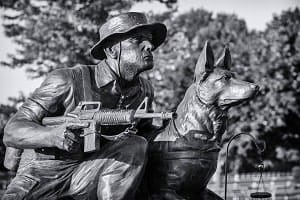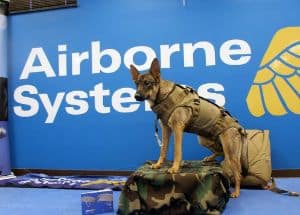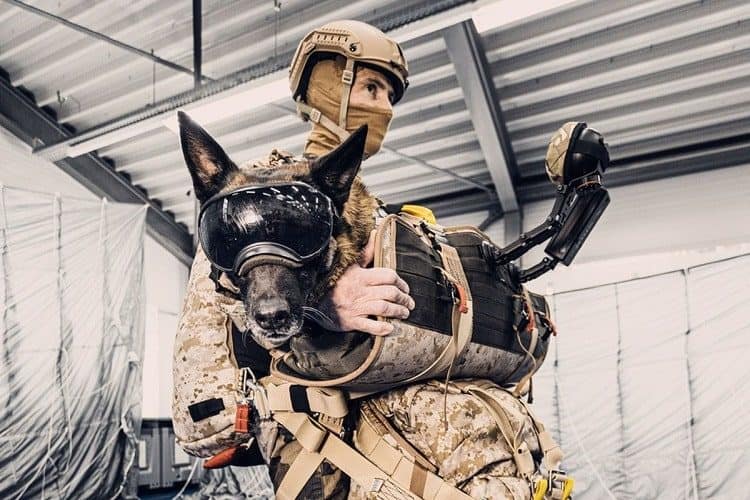A new flight pod-style harness called the K9F Para-fox is making it possible for military dogs to parachute safely – and more comfortably –with their handlers. The concept has actually been in the works for years, but the sixth and final iteration of the harness was recently unveiled in December 2020, making it possible for dogs in combat, along with their handlers, to reach the ground safely.
Dogs have been our best friends for nearly 23,000 years, and canines in combat have been around for almost 3,000 years. From sniffing out the enemy to detecting bombs and booby-traps, dogs have served beside humans through multiple historical wars and other conflicts.
However, the military working dog wasn’t officially recognized until after WWI. In 1942, Dogs For Defense, a private organization, gathered dogs from the public to join the K-9 Corps, the U.S. military’s War Dog Program. Since then, military dogs have been bred, trained, and geared-up for active duty.
Now, today’s military working dogs have the privilege of parachuting – safely – to the ground with their handler, thanks to a new flight-pod harness made special for canines in combat, according to Popular Science. The flight-pod, the K9F Para-fox, was made to securely hold the dog during extreme maneuvers while creating a safer landing for both the handler and military dog.

Top view of the K9F Para-fox.
Photo Courtesy: Paratec via Popular Science
The K9F Para-fox was unveiled at the December 2020 Defense Innovation Forum in Europe. Created by a German company, Paratec, the K9F Para-fox is the sixth, and final, version of a dog parachute harness – a concept that actually began eight years ago.
In 2012, Paratec created the Working Dog Freefall Harness, or K9A, which attached to the front of the paratrooper’s harness. However, the dog’s legs still dangled, which often made it difficult for the paratrooper to maneuver, control the chute, and land together with the dog, and do so without injury.
“The animal’s welfare was first and foremost. It had to be comfortable, ventilated, have its legs protected and be secure. We had to make sure that our equipment did not hinder the use of various accessories the dog may be wearing such as goggles, a leash, or a kevlar vest to protect it from being knifed after landing. The pod also had to be expandable to take account of different sized dogs,” said Ken Krueger, the business development manager for Paratec, according to Popular Science.
Paratec upgraded its 2012 version of the dog parachute harness, the K9A, in 2014 to lengthen the harness. But the creators were still unsure what to do with the dogs’ legs. In 2015, the French military contacted Paratec to make a special parachute for the dog of Captain Jerome, the commander of the 132nd dog-handling infantry regiment. This sparked new ideas, and the K9F was born.

Photo Courtesy: Pixabay
The K9F dog parachute harness is shaped like a large sack and is made from cordura and spandex. It features a soft lining and is referred to as a flight-pod. The pod, which resembles a square burrito or taco, opens up to a flat surface so the dog can lie down on it. Military dogs are trained to tuck their legs underneath them in order to jump up quickly. This position also reduces the risk of broken bones due to a hard landing.
The dog is then secured in the flight-pod via a zipper and outfitted with a neoprene and spandex collar, which has been designed with a magnetic release. The dog in the pod, supported in the harness like a burrito, is attached to the handler, and the two are ready to jump together. Upon landing, the pod is designed to pop open in less than 10 seconds so the dog can spring into action.
“It’s a bit like those seams that shut sacs of potatoes. When you pull on one thread the whole seam comes undone,” explained Krueger, according to Popular Science. The flight-pod can be “threaded” back up to be used again.

Photo Courtesy: Airborne Systems
Parachuting dogs in the military is not a new occurrence, as seen with the Navy SEALs. Navy SEAL dogs also parachute with a handler but may do small jumps on their own into the water using a flotation device. The Marine Corps also has 23 dog parachute harnesses from Airborne Systems, according to Popular Science.
Currently, there are more than 2,300 working dogs in the military, according to Military Benefits. U.S. military working dogs and their handlers train in Texas at the 341st Training Squadron at the Lackland Air Force Base. There, the Department of Defense, or DoD, breeds and trains dogs specifically for military combat. Puppies are fostered to socialize, then returned to the base for training. Dogs who do well go on to active service. Dogs who don’t do well in the training program are put up for adoption.
The War Dog Training Program is a 120-day program that includes obedience training, combat tactics, and contraband detection. Military working dogs are then taught how to work in teams and deployed after successfully completing the training program.
Featured Photo Courtesy: Paratec via Popular Science







